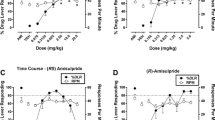Abstract
Pigeons were successfully trained to discriminate 60 mg/kg valproic acid from saline using a two-key drug discrimination procedure. When 5–80 mg/kg doses of valproic acid were administered during generalization tests the percentage of responses directed to the valproic acid-appro-priate key varied directly with dose. the effects of administering the training dose of valproic acid at presession injection intervals ranging from 15 to 120 min were described by an inverted U-shaped function; the 30-min interval used during discrimination training engendered the largest percentage of valproic acid-appropriate responses. The discriminative stimulus properties of valproic acid failed to generalize to the anticonvulsant compounds phenobarbital (10, 20 mg/kg), phenytoin (2.5, 5 mg/kg), and ethosuximide (40, 80 mg/kg), indicating that not all anticonvulsant compounds share similar discriminative properties. Clonazepam (0.25, 0.50 mg/kg) and diazepam (1, 2 mg/kg), two benzodiazepines with anticonvulsant properties, produced quite different effects. The stimulus properties of valproic acid generalized to all doses of clonazepam, whereas intermediate generalization was evident with diazepam. Pentylenetetrazol (10, 20 mg/kg), chlorpromazine (5, 10 mg/kg), tripelennamine (2.5, 5.0 mg/kg), d-amphetamine (0.5, 1.0 mg/kg), morphine (1.25, 2.50 mg/kg), and imipramine (2.5, 5.0 mg/kg) induced only saline-like patterns of responding. The concomitant administration of pentylenetetrazol failed to antagonize the discriminative stimulus properties exerted by the training dose of valproic acid.
Similar content being viewed by others
References
Brown PL, Jenkins HM (1968) Auto-shaping the pigeons key-peck. J Exp Anal Behav 11:1–8
Colpaert FC, Desmedt, LKC, Janssen PAJ (1976) Discriminative stimulus properties of benzodiazepines, barbiturates, and pharmacologically related drugs; relation to some intrinsic and anticonvulsant effects. Eur J Pharmacol 37:113–123
Geller I, Seifter J (1960) The effects of meprobamate, barbiturates, d-amphetamine and promazine on experimentally induced conflict in the rat. Psychopharmacologia 1:482–492
Gibbs EL, Gibbs TJ, Gibbs FA, Gibbs EA, Dikmen S, Hermann BP (1982) Antiepilepsy drugs. In: Breuning S, Poling A (eds) Drugs and mental retardation Chales C Thomas, Springfield IL, pp 268–329
Herling S, Valentino RJ, Winger GD (1980) Discriminative stimulus effects of pentobarbital in pigeons. Psychopharmacology 71:21–28
Herling S, Winger G (1981) Selective blockade of the discriminative stimulus effects of pentobarbital in pigeons. Psychopharmacology 75:321–323
Karas CA, Picker M, Poling A (1985) The discriminative stimulus properties of tripelennamine in the pigeon. Psychopharmacology (in press)
Krafft K, Cleary J, Poling A (1983) Discriminative stimulus properties of phenytoin in the pigeon. Psychopharmacology 79:82–83
Krimmer EC, Barry III H, Alvin JD (1982) Discriminative, disinhibitory, and depressant effects of several anticonvulsants. Psychopharmacology 78:28–32
Lal H, Shearman GT, Fielding S, Dunn R, Kruse H, Theurer K (1979) Effect of valproic acid on anxiety related behaviors in the rat. Brain Res Bull 4:711
Lal H, Shearman GT, Fielding S, Dunn R, Kruse H, Theurer K (1980) Evidence that GABA mechanisms mediate the anxiolytic action of benzodiazepines: A study with valproic acid. Neuropharmacology 19:785–789
Lambert PA, Borselli S, Marcou G, Bouchardy M, Carbol C (1971) Action tyhmo-regulatrice a longterme du Depamide dans la psychose maniaco-depressive. Ann Med Psychol (Paris) 2:442–447
Lambert PA, Carraz G, Borselli S, Bouchardy M, Carbol C (1975) Le diproylacetamide dans le traetement de la psychose maniaco-depressive. L' Encephale 1:25–31
Overton DA (1982) Comparison of the degree of discriminability of various drugs using a t-maze discrimination paradigm. Psychopharmacology 76:385–395
Picker M, Poling A (1984) Effects of anticonvulsants on learning: Performance of pigeons under a repeated acquisition procedure when exposed to phenobarbital, clonazepam, valproic acid, ethosuximide, and phenytoin. J Pharmacol Exp Ther 230:307–316
Picker M, Thomas J, Koch C, Poling A (1985a) Effects of phenytoin, phenobarbital, and valproic acid, alone and in selected combinations, on schedule-controlled behavior in rats. Pharmacol Biochem Behav 22:389–393
Picker M, White W, Poling A (1985b) Effects of phenobarbital, clonazepam, valproic acid, ethosuximide, and phenytoin on the delayed-matching-to-sample performance of pigeons. Psychopharmacology (in press)
Puzynski S, Klosiewicz L (1984) Valproic acid amide as a prophylactic agent in affective and schizoaffective disorders. Psychopharmacol Bull 20:151–159
Rall TW, Schleifer LS (1980) Drugs effective in the therapy of epilepsies. In: Gilman AG, Goodman LS, Gilman A (eds) The pharmacological basis of therapeutics. MacMillan, New York, pp 448–474
Shearman G, Lal H (1979) Discriminative stimulus properties of pentylenetetrazol and bemegride: Some generalization and antagonism tests. Psychopharmacology 64:315–319
Shearman G, Lal H (1980) Generalization and antagonism studies with convulsant, GABA erigic and anticonvulsant drugs in rats trained to discriminate pentylenetetrazol from saline. Neuropharmacology 19:473–479
Sommerbeck KW, Theilgaard A, Rasmussen KE, Lohren V, Gram L, Wulff K (1977) Valproate sodium: Evaluation of so-called psychotropic effect. A controlled study. Epilepsia 18:159–167
Woodbury DM, Penry JK, Pippenger CE (1982) Antiepileptic drugs. Raven Press, New York
Author information
Authors and Affiliations
Rights and permissions
About this article
Cite this article
Picker, M., Wallace, S., Hancock, S. et al. Discriminative stimulus properties of valproic acid in the pigeon. Psychopharmacology 87, 449–453 (1985). https://doi.org/10.1007/BF00432511
Received:
Accepted:
Issue Date:
DOI: https://doi.org/10.1007/BF00432511




